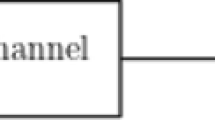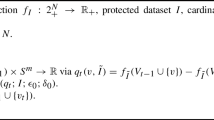Abstract
A subspace design is a collection {H 1, H 2, ...,H M } of subspaces of \(\mathbb{F}_q^m\) with the property that no low-dimensional subspace W of \(\mathbb{F}_q^m\) intersects too many subspaces of the collection. Subspace designs were introduced by Guruswami and Xing (STOC 2013) who used them to give a randomized construction of optimal rate list-decodable codes over constant-sized large alphabets and sub-logarithmic (and even smaller) list size. Subspace designs are the only non-explicit part of their construction. In this paper, we give explicit constructions of subspace designs with parameters close to the probabilistic construction, and this implies the first deterministic polynomial time construction of list-decodable codes achieving the above parameters.
Our constructions of subspace designs are natural and easily described, and are based on univariate polynomials over finite fields. Curiously, the constructions are very closely related to certain good list-decodable codes (folded RS codes and univariate multiplicity codes). The proof of the subspace design property uses the polynomial method (with multiplicities): Given a target low-dimensional subspace W, we construct a nonzero low-degree polynomial P W that has several roots for each H i that non-trivially intersects W. The construction of P W is based on the classical Wronskian determinant and the folded Wronskian determinant, the latter being a recently studied notion that we make explicit in this paper. Our analysis reveals some new phenomena about the zeroes of univariate polynomials, namely that polynomials with many structured roots or many high multiplicity roots tend to be linearly independent.
Similar content being viewed by others
References
A. Bostan and P. Dumas: Wronskians and linear independence, American Mathematical Monthly 117 (2010), 722–727.
Z. Dvir, S. Kopparty, S. Saraf and M. Sudan: Extensions to the method of multiplicities, with applications to Kakeya sets and Mergers, in: Proceedings of the 50th Annual IEEE Symposium on Foundations of Computer Science, 181–190, IEEE Computer Society, 2009.
Z. Dvir and S. Lovett: Subspace evasive sets, in: Proceedings of the 44th ACM Symposium on Theory of Computing, 351–358, 2012.
M. A. Forbes and A. Shpilka: On identity testing of tensors, low-rank recovery and compressed sensing, in: Proceedings of the 44th Symposium on Theory of Computing Conference, 163–172, 2012.
A. Garcia and J. F. Voloch: Wronskians and linear independence in fields of prime characteristic, Manuscripta Mathematica 59 (1987), 457–469.
V. Guruswami: Cyclotomic function fields, Artin-Frobenius automorphisms, and list error-correction with optimal rate, Algebra and Number Theory 4 (2010), 433–463.
V. Guruswami and A. Rudra: Explicit codes achieving list decoding capacity: Error-correction with optimal redundancy, IEEE Transactions on Information Theory 54 (2008), 135–150.
V. Guruswami and C. Wang: Linear-algebraic list decoding for variants of Reed-Solomon codes, Electronic Colloquium on Computational Complexity (ECCC) 19 (2012). To appear in IEEE Trans. Info. Theory, 20–3.
V. Guruswami and C. Wang: Explicit rank-metric codes list-decodable with optimal redundancy, CoRR abs/1311.7084, 2013.
V. Guruswami and C. Xing: Folded codes from function field towers and improved optimal rate list decoding, in: Proceedings of the 44th ACM Symposium on Theory of Computing, 339–350, 2012.
V. Guruswami and C. Xing: List decoding Reed-Solomon, Algebraic-Geometric, and Gabidulin subcodes up to the Singleton bound, Electronic Colloquium on Computational Complexity (ECCC) 19 146, 2012. Extended abstract to appear in the Proceedings of the 2013 ACM Symposium on Theory of Computing.
V. Guruswami and C. Xing: Optimal rate algebraic list decoding using narrow ray class fields, CoRR arXiv:1302.6660 [math.NT], 2013.
S. Kopparty: List-decoding multiplicity codes, Electronic Colloquium on Computational Complexity (ECCC) 19, 2012.
F. Manganiello, E. Gorla and J. Rosenthal: Spread codes and spread decoding in network coding, in: Proceedings of the IEEE International Symposium on Information Theory, 881–885, 2008.
T. Muir: A Treatise on the theory of determinants, Dover books on advanced mathematics. Dover Publications, 1882.
F. E. Oggier and A. Datta: Self-repairing codes for distributed storage — a projective geometric construction, CoRR abs/1105.0379, 2011.
F. Parvaresh and A. Vardy: Correcting errors beyond the Guruswami-Sudan radius in polynomial time, in: Proceedings of the 46th Annual IEEE Symposium on Foundations of Computer Science, 285–294, 2005.
Author information
Authors and Affiliations
Corresponding author
Additional information
Research supported in part by a Packard Fellowship and NSF CCF-0963975.
Research supported in part by a Sloan Fellowship and NSF CCF-1253886.




